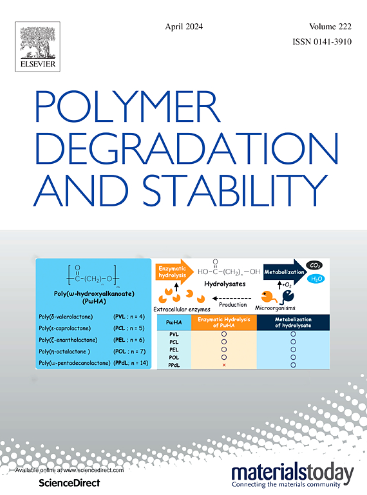Physical properties and chemical structure evolution mechanism of AMPS-based copolymer oil well cement retarder in ultra-high temperature alkaline solution environment
IF 6.3
2区 化学
Q1 POLYMER SCIENCE
引用次数: 0
Abstract
2-Acrylamido-2-methylpropanesulfonic acid (AMPS) based copolymer retarder is one of the most commonly used oil well cement additives in cementing engineering. However, its performance decline caused by the thermal degradation behavior in ultra-high temperature (UHT) environment is particularly prominent, and the underlying mechanism remains unclear. In view of this issue, the physical properties and chemical structure evolution mechanism of two kinds of representative oil well cement copolymer retarder, namely the anionic binary copolymer PAI [AMPS-co-itaconic acid (IA)] and the heterocyclic zwitterionic quaternary copolymer PAINM [AMPS-co-IA-co-N-vinylpyrrolidone (NVP)-co-methacrylamido propyl trimethylammonium chloride (MAPTAC)], were comparatively investigated in UHT alkaline solution environment, aiming to provide theoretical guidance for the optimization design strategy of improving the UHT efficiency of retarder in future research. The results indicated that copolymer retarders had significant thermal degradation behavior in UHT alkaline solution environment (T ≥ 200 °C, pH≈13), which was manifested in the decrease of apparent viscosity and viscosity-average molecular weight, the change of pH value, the variation of side groups and the pyrolysis of main chain (producing unsaturated alkenes). Both the hydrolysis of amide bond and the decarboxylation reaction in the copolymer side chains would lead to the configuration transformation of carboxyl from di-carboxyl to mono-carboxyl, and the thermal degradation behavior made the main chain configuration of the aged product severely deviate from the initial structure. The above two factors were the main reasons for the retarding efficiency reduction of copolymers at UHT. Furthermore, the introduction of rigid cyclic and cationic side groups could slightly delay the main chain rupture and the decarboxylation process, but was unable to reverse the thermal degradation progress of the copolymer retarder.
超高温碱性溶液环境下amps基共聚物油井水泥缓凝剂物理性能及化学结构演化机理
2-丙烯酰胺-2-甲基丙磺酸(AMPS)基共聚缓凝剂是固井工程中最常用的油井水泥添加剂之一。然而,其在超高温(UHT)环境下的热降解行为导致的性能下降尤为突出,其潜在机制尚不清楚。针对这一问题,在UHT碱性溶液环境下,对比研究了两种具有代表性的油井水泥共聚物缓凝剂——阴离子二元共聚物PAI [amps -co-IA-co- n -乙烯基吡啶酮(NVP)-共甲基丙烯酰胺丙基三甲基氯化铵(MAPTAC)]和杂环两性离子季铵盐共聚物PAINM [amps -co-IA-co- n -乙烯基吡啶酮(NVP)]的物理性质和化学结构演化机理。旨在为今后研究中提高超高温阻速器效率的优化设计策略提供理论指导。结果表明,共聚物缓凝剂在UHT碱性溶液环境下(T≥200℃,pH≈13)具有明显的热降解行为,表现为表观粘度和粘度-平均分子量的降低、pH值的变化、侧基的变化以及主链的热解(生成不饱和烯烃)。酰胺键的水解和共聚物侧链上的脱羧反应都会导致羧基由二羧基向单羧基的构型转变,热降解行为使老化产物的主链构型严重偏离初始结构。以上两个因素是导致共聚物在超高温下缓速效率下降的主要原因。此外,刚性环基和阳离子侧基的引入可以略微延缓主链断裂和脱羧过程,但不能逆转共聚物缓凝剂的热降解过程。
本文章由计算机程序翻译,如有差异,请以英文原文为准。
求助全文
约1分钟内获得全文
求助全文
来源期刊

Polymer Degradation and Stability
化学-高分子科学
CiteScore
10.10
自引率
10.20%
发文量
325
审稿时长
23 days
期刊介绍:
Polymer Degradation and Stability deals with the degradation reactions and their control which are a major preoccupation of practitioners of the many and diverse aspects of modern polymer technology.
Deteriorative reactions occur during processing, when polymers are subjected to heat, oxygen and mechanical stress, and during the useful life of the materials when oxygen and sunlight are the most important degradative agencies. In more specialised applications, degradation may be induced by high energy radiation, ozone, atmospheric pollutants, mechanical stress, biological action, hydrolysis and many other influences. The mechanisms of these reactions and stabilisation processes must be understood if the technology and application of polymers are to continue to advance. The reporting of investigations of this kind is therefore a major function of this journal.
However there are also new developments in polymer technology in which degradation processes find positive applications. For example, photodegradable plastics are now available, the recycling of polymeric products will become increasingly important, degradation and combustion studies are involved in the definition of the fire hazards which are associated with polymeric materials and the microelectronics industry is vitally dependent upon polymer degradation in the manufacture of its circuitry. Polymer properties may also be improved by processes like curing and grafting, the chemistry of which can be closely related to that which causes physical deterioration in other circumstances.
 求助内容:
求助内容: 应助结果提醒方式:
应助结果提醒方式:


